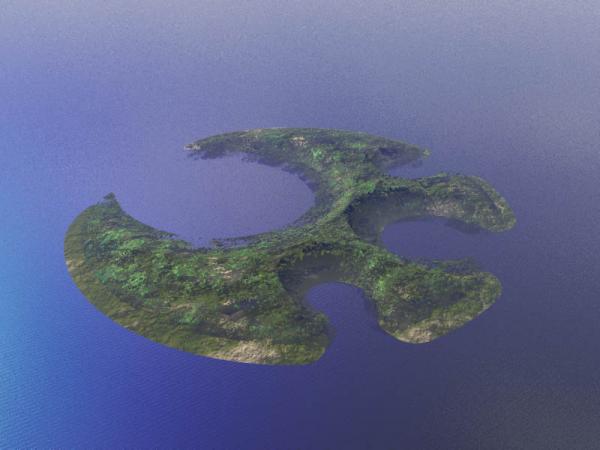BY LETTER
Lyonesse
History > 0030 to 0900 AT: Solsys Era > 030 to 130 AT: The Information Age
History > 0030 to 0900 AT: Solsys Era > 130 to 400 AT: The Interplanetary Age
History > 0030 to 0900 AT: Solsys Era > 400 to 530 AT: The Solsys Golden Age
History > 0030 to 0900 AT: Solsys Era > 530 to 900 AT: The Sundering
Galactography > Places and Locales
History > 0030 to 0900 AT: Solsys Era > 130 to 400 AT: The Interplanetary Age
History > 0030 to 0900 AT: Solsys Era > 400 to 530 AT: The Solsys Golden Age
History > 0030 to 0900 AT: Solsys Era > 530 to 900 AT: The Sundering
Galactography > Places and Locales
 Image from Anders Sandberg | |
| Lyonesse after completion of the substrate but before construction of the city | |
Lyonesse was an artificial island in the English Channel between mainland Europe and Britain on pre-Expulsion Earth.
When the European Union reformed into the European Federation in 2066 CE (97 AT), the treaty included a provision that the new federation would establish a new capital on neutral territory not belonging to any of the member states. This necessitated constructing a new landmass in formerly international waters, though such a feat was much more feasible than it would have been many decades before due to advancements in robotic dredging and earthworks. After two years of design, the construction of the new capital, to be named Lyonesse, commenced.
The new island was 5 kilometers across, in the form of a thick crescent with three smaller harbors cut into the outer curve. Once the island was finished, construction of the city began. Lyonesse welcomed its first residents in 2084 CE (116 AT), though urban construction continued for several years more.
The city prospered throughout the Interplanetary Age, attracting many forward-thinking leaders and researchers. The University of Lyonesse soon became renowned for its theoretical and applied research in artificial intelligence, as well as many breakthroughs in ecotech to mitigate and reverse climate change. The success of Lyonesse motivated the government to try to build more Federal Cities, but the Great Downturn in the 2120s CE (150s AT) killed off this effort. The only new city that had been partially built, Aristos, was sold off to Academion. Nonetheless, as a center of government, Lyonesse itself weathered the crisis well.
Beginning nearly a century later, however, the increasing population necessitated an expansion of Lyonesse no longer just upward with taller buildings but outward into the sea. By 2369 CE (400 AT), the city was 36 km across on average, with an area of nearly a thousand square kilometers. The original island shape had long since been subsumed into a more irregular landmass, though the street layout in the Old Core bore the legacy of the original design.
In 2375 CE (406 AT), under heavy pressure from the Council of Earth due to ecological concerns, a moratorium was placed by the European Federation on further outward expansion of the city. For the ensuing century and a half, the city became more 'arcologized' but did not increase in population at the same rate as previously. By the Federal Census of 2528 CE (559 AT), Lyonesse had a population of about 14,450,000.
When the Technocalypse struck in 2534 CE (565 AT), Lyonesse was particularly hard hit. In the aftermath the federal government reconstituted itself as a largely distributed organization scattered across European territory, while Lyonesse itself was mostly abandoned and fell into ruin. In the following decades, the island became a lawless refuge for pirates and squatters. This state of affairs continued until the Great Expulsion in 2590 CE (621 AT), after which the island was dismantled and sunk below the waves by GAIA. Today, thanks to the Gaiacene Ice Age, the English Channel is now above water and home to nomadic groups of the Children of GAIA, none of whom are known to have exhibited interest in the lost city.
Today nothing remains in Lyonesse's physical location, but it is remembered as one of the earliest instances of when Terragens set out to reshape the physical world into habitations of their own making. Though rare, a few historical enthusiasts have been known to create replicas (generally anachronistic or contradictory) of Lyonesse, with a few different versions with varying interpretations of fragmentary details existing as physical replicas or as virches in the Fomalhaut Acquisition Society.
Related Articles
Appears in Topics
| 030 to 130 AT: The Information Age | 130 to 400 AT: The Interplanetary Age | 400 to 530 AT: The Solsys Golden Age |
| 530 to 900 AT: The Sundering | Places and Locales |
Development Notes
Text by ProxCenBound, expanding an original by Steve Bowers
Revised 9 September 2023.
Initially published on 18 November 2009.
Revised 9 September 2023.
Initially published on 18 November 2009.






